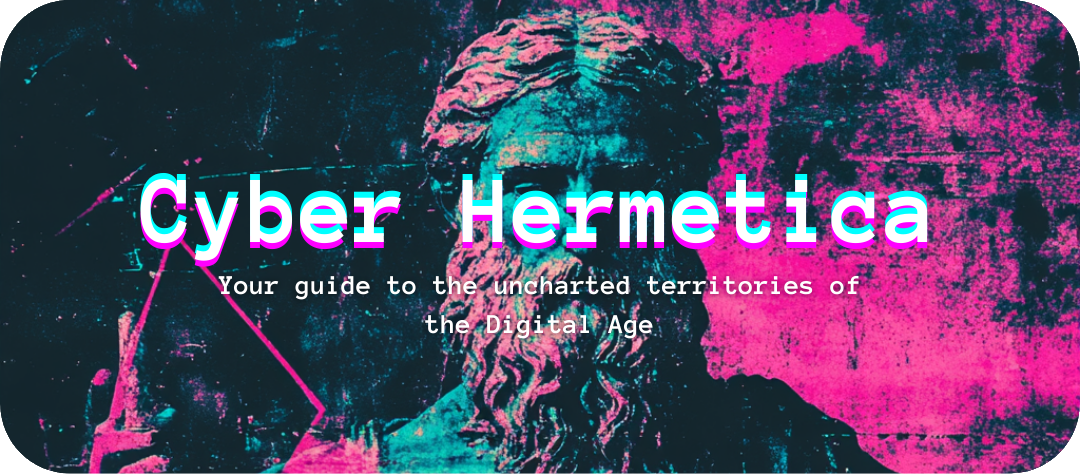Hi there, I’m Matte. Privacy & cybersecurity professional by day, schizo-cyberoccultist by night. Every sunday I bring you a weekly dose of schizophrenization, blending insights into the Digital Age, echoes from the past and digital survival tips. If you like this, you will also enjoy the rest of Cyber Hermetica!
⚡ SEMIOTIC FLASHES
Personal weekly considerations. Decrypting meaning, one flash at a time.
Vibe coding and cybernetic choreographies
There’s a new way to develop software: it’s called vibe coding. This is how Andrej Karpathy, former Director of AI at Tesla and former developer at OpenAI, defines it.
Far from the traditional, rational approach of structured programming, vibe coding embraces an intuitive, fluid workflow entirely mediated by LLMs (large language models like ChatGPT). Karpathy’s iconic statement encapsulates the concept: “the hottest new programming language is English.”
Andrej uses tools like Cursor Composer and SuperWhisper to communicate directly with AI, generating, modifying, and debugging code without touching the keyboard — like a composer or a sorcerer conjuring virtual realities through voice and magic formulas.
His vibe coding pushes the stream of consciousness to its limits. Despite being an experienced developer, he admits to accepting all AI-suggested changes without even reading the code. If errors arise, he simply copies and pastes them into the prompt, letting the AI resolve the issue.
As fun as it sounds, this method is not yet suitable for professional software development. As some have noted, AI-generated code accumulation can lead to massive, complex monoliths that are difficult to maintain. Such code would require extensive refactoring to become usable at a professional level. Yet, even this challenge could be overcome by AI: if vibe coding becomes widespread, we might soon see hyper-specialized AI agents dedicated solely to refactoring.
In other words, in the near future, AI may not only write code but also restructure it autonomously, turning software development into a pure co-creation process with AI.
Notably, developer and AI would become two nodes in a cybernetic process composed of continuous feedback and feedforward loops.
The algorithm continuously learns from its errors and successes, as well as from user interactions (feedback). Simultaneously, both user and AI anticipate each other’s future behavior, adapting accordingly, predicting potential code issues before they arise, or interpreting inputs and outputs differently.
In this almost alchemical scenario, two opposites dance together: vibe coding becomes a cybernetic choreography where the human dreams, imagines, and shapes, while the AI executes, optimizes, and materializes. The boundary between thinking and doing will increasingly dissolve, creating a symbiosis between human and artificial minds: what the human mind can imagine, the artificial mind can realize.
💻 DIGITAL GRIMOIRE
Digital survival tactics: OpSec, Cybersec, OSINT, and AI tools to dominate the Digital Age.
Anatomy of a prompt
Ever struggled to get the answer you wanted from an AI? Improving your prompts can make a big difference. A prompt is a set of instructions that guide the AI toward the desired outcome. The better the prompt, the more likely the AI will provide a useful response.
For example, asking “Summarize this article in 100 words” is clearer than just saying “Summarize this.”
Here’s how to structure an effective prompt:
Goal: Clearly state what you aim to achieve.
Return format: Specify how you want the AI to respond (e.g., bullet points, paragraph, table) to avoid disappointment.
Warnings: Indicate what the AI should avoid or verify (e.g., “Exclude outdated sources” or “Double-check technical terms”).
Context dump: Provide background information to help the AI understand the bigger picture. Adding examples can also improve accuracy.
Or, you know, just go with the flow and see where it takes you.

📡 DIGITAL SIGNALS
Transmissions from the infosphere: world events, data breaches and news that impact our digital reality.
Using AI to decode language from the brain. Meta has unveiled significant advances in artificial intelligence applied to the study of language and the human brain. Using MEG (Magnetoencephalography) signals, their AI reportedly decoded up to 80% of the participants’ thoughts with precision as they typed sentences on a screen. The AI allowed researchers to observe how the brain transforms abstract thoughts into words and actions, paving the way for important innovations in the field of neurotechnology.
🌐 SUBSTACK’S SUBNET
Emerging voices: articles and contents on Substack, handpicked by me to inspire and connect.
The Techgnosis Manifesto. This week I was happy to discover the Techgnosis Manifesto, a document that promotes a mindful use of technology while preserving human experience, creativity, and connection with nature as we explore spiritual dimensions. A manifesto that, in a few parts, honestly feels a bit banal to me, yet somehow also represents my own vision. After all, it’s the reason I chose to name this newsletter Cyber Hermetica. I recommend reflecting on these topics.
📟 RETROWAVE
Fragments from the past: cypherpunk mailing lists, cybernetic cults, hacker zines and forgotten digital prophets from the 90s and onward.
Genesis of neolemurianism, part 6
Even after his recovery, the sense of oppression persisted, like a “new dimension of gravity.” The vision had granted him “horrific insight into the jail-house mind of the One God.” He was convinced the knowledge was ‘dangerous’ and that “powerful forces were conspiring against him,” that the “invisible brothers are invading present time” (WV 220). The episode sharpened his already vivid impression that the human animal is cruelly caged in time by an alien power. Recalling it later, he would write:
“Time is a human affliction; not a human invention but a prison” (GC 16-17).
Although no direct historical evidence supports Kaye’s description of events, the period immediately following the 1958 ‘episode’ provides compelling symptomatic evidence of a transformation in Burroughs’s strategies and preoccupations during this time. It was then that Burroughs’s writing underwent a radical shift in direction, introducing experimental techniques aimed solely at escaping the bonds of the already-written, charting a flight from destiny.
Gysin’s role in the discovery of these cut-ups and fold-ins is well-known, but Kaye’s story accounts for the special urgency with which Burroughs began deploying these new methods in late 1958.
The cut-ups and fold-ins were “innovative time-war tactics,” designed to subvert the foundations of the prerecorded universe. “Cut the Word Lines with scissors or switchblades as preferred ... The Word Lines keep you in time...” (WV 270).
Burroughs’s adoption of these techniques was, as Kaye told the CCRU, “one of the first effects (if one may be permitted to speak in so loose a way) of the time-trauma.”
Kaye naturally attributes Burroughs’s intense antipathy towards prerecording – a persistent theme in his fiction after The Naked Lunch – to his experiences in the Vysparov library. The “cosmic revelation” in the library produced in Burroughs
“a horror so profound” that he would dedicate the rest of his life to plotting and propagating escape routes from “the board rooms and torture banks of time” (NE 33).
Much later, Burroughs described a crushing feeling of inevitability, of life being scripted in advance by malign entities:
“The custodians of the future convene. Keepers of the Board Books: Mektoub, it is written. And they don’t want it changed” (GC 8).
In the immediate aftermath of the Vysparov library episode, Burroughs exhibited the first signs of an apparently random attachment to lemurs, the decisive implications of which took several decades to surface.
Burroughs was unsure who was running him, like“a spy in somebody else’s body where nobody knows who is spying on whom” (WV xxviii). Until the end of his life, he struggled against the ‘Thing inside him. The Ugly Spirit,’
remarking that:“I live with the constant threat of possession, and a constant need to escape from possession, from Control” (WV 94)…
🌀 SYMBOLS
Memes: visual symbols that decode the schizophrenia of the Digital Age.
Did you read the latest on Cyber Hermetica?
Return next week for another schizotechnic rendezvous.








